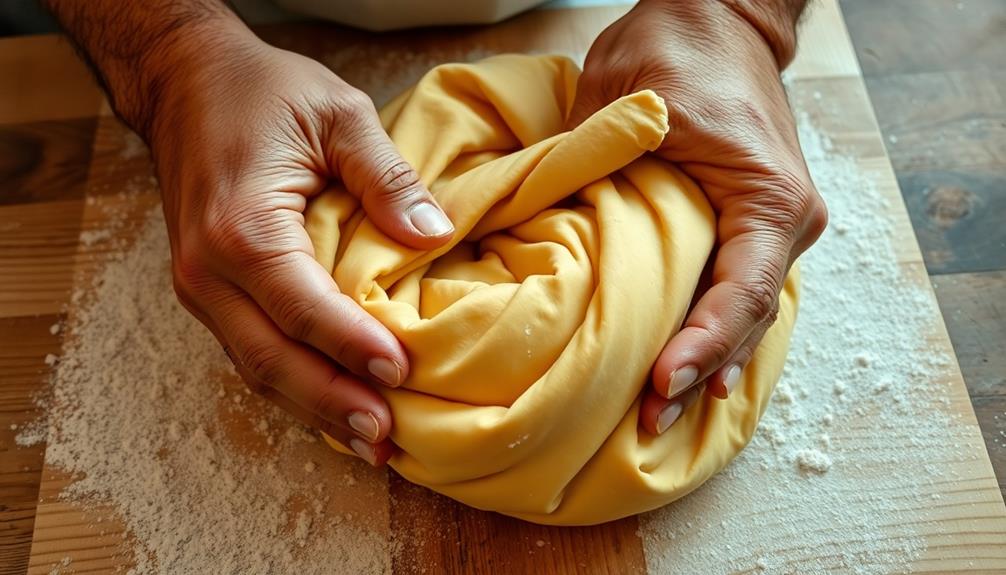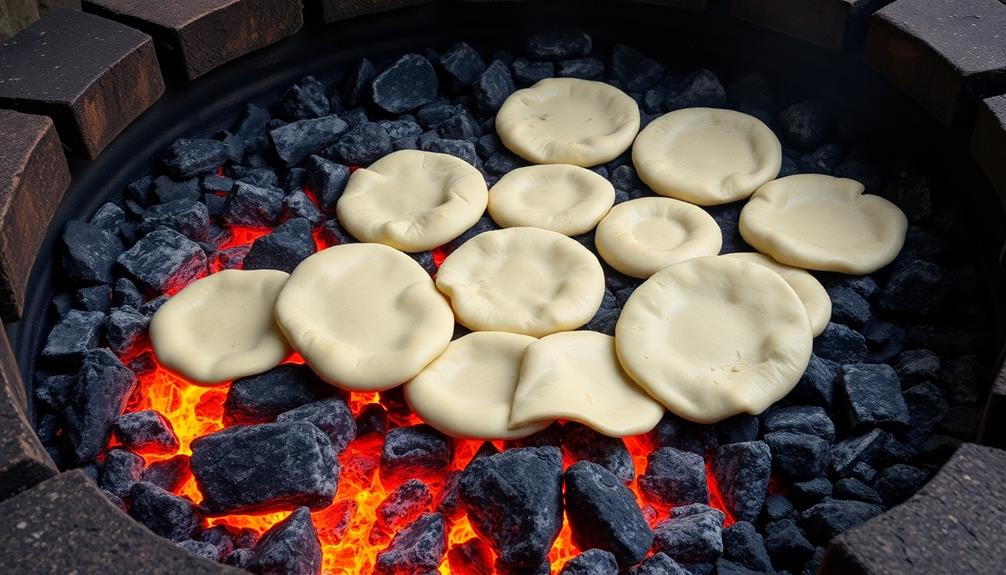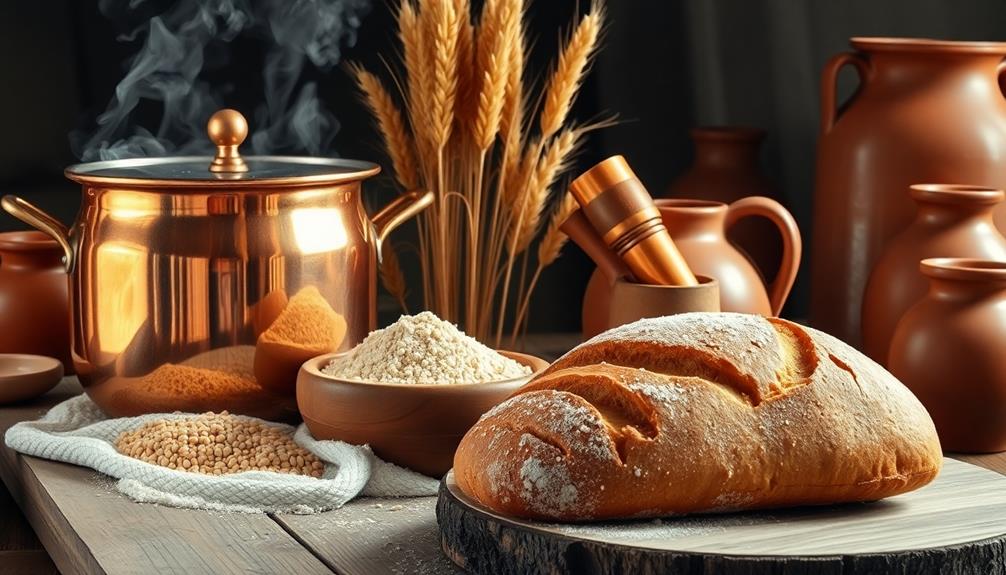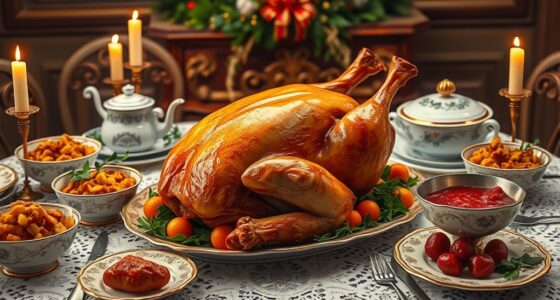Ancient Egyptian cuisine centered around the hearty staples of bread and beer, which sustained both commoners and royalty. Wheat and barley formed the foundation, supplemented by fruits, vegetables, and livestock. Food preparation involved techniques like baking, boiling, and roasting in clay ovens and pots. Elaborate royal banquets featured diverse ingredients introduced through trade and conquest, while daily life revolved around these humble yet nourishing dishes. Uncovering the culinary heritage of this enduring civilization offers a glimpse into the rich cultural traditions that continue to captivate and inspire.
Key Takeaways
- Staple ingredients in ancient Egyptian cuisine included wheat, barley, dates, lentils, beans, vegetables, fish, and poultry.
- Bread-making and beer production were integral to daily life, with bakeries and breweries playing a significant role.
- Cooking techniques involved baking, boiling, and roasting, with food preservation methods such as drying and salting.
- Elaborate royal banquets featured diverse culinary traditions, reflecting the civilization's cultural beliefs and social structures.
- Ancient Egyptian cuisine has influenced modern Middle Eastern cuisine, with its flavors and techniques remaining relevant today.
History
Though the ancient Egyptians were known for their elaborate tombs and monuments, their daily cuisine was surprisingly simple yet nourishing.
Bread and beer formed the staples of the Egyptian diet, supplemented by a variety of fruits, vegetables, and livestock. Archaeologists have uncovered numerous bakeries and breweries, indicating the importance of these basic foods in Egyptian life.
Interestingly, the menu for the elite, including the pharaohs, wasn't vastly different from that of the common people. Royal banquets featured more elaborate preparations and exotic ingredients, but the core dishes remained the same.
Over time, trade and conquest introduced new foodstuffs, like spices and olive oil, which gradually became incorporated into Egyptian cuisine.
Despite these changes, the essence of ancient Egyptian food – wholesome, simple, and deeply rooted in the Nile valley – endured for thousands of years, reflecting the resilience and adaptability of this ancient civilization.
Recipe
Ancient Egyptian Cuisine: Recipe
Ancient Egyptians were known for their diverse and sophisticated culinary traditions, which were deeply intertwined with their religious and cultural beliefs. One such dish that has endured through the ages is a hearty and flavorful stew, often served during special occasions and celebrations.
This recipe for an ancient Egyptian stew captures the essence of the region's rich culinary heritage, using a combination of locally sourced ingredients and traditional cooking methods. Prepare to embark on a journey through time as you recreate this timeless dish in your own kitchen.
- Lamb or beef, cubed
- Onions, diced
- Carrots, peeled and sliced
- Celery, diced
- Tomatoes, diced
- Garlic, minced
- Egyptian spice blend (cumin, coriander, cinnamon, and black pepper)
- Barley or emmer wheat
- Vegetable or meat broth
- Salt and pepper to taste
In a large pot, sear the meat over medium-high heat until browned on all sides. Remove the meat from the pot and set aside.
Add the onions, carrots, and celery to the pot and sauté until softened, about 5-7 minutes. Stir in the garlic and spice blend, and cook for an additional minute until fragrant.
Return the meat to the pot and add the diced tomatoes, barley or emmer wheat, and enough broth to cover the ingredients. Bring the mixture to a boil, then reduce the heat to low, cover, and simmer for 1-2 hours, or until the meat and grains are tender.
When serving this ancient Egyptian stew, consider garnishing it with fresh herbs, such as parsley or cilantro, to enhance the flavors.
Additionally, you may wish to serve it alongside flatbread or a simple salad to create a more complete and authentic dining experience.
Cooking Steps
First, you'll need to soak the emmer wheat overnight.
Then, grind the soaked wheat to create a dough.
Step 1. Soak Emmer Wheat Overnight

To prepare the emmer wheat, you'll need to soak it overnight. Emmer, an ancient wheat variety, was a dietary staple in ancient Egypt.
Start by thoroughly rinsing the wheat grains in cool water. Then, place them in a large bowl and cover them with fresh water. Let the grains soak for at least 8 hours, or overnight. This process softens the tough outer hull and kickstarts the germination process, making the wheat easier to grind into flour.
During the soaking, you might need to add more water to ensure the grains remain fully submerged. Once the soaking is complete, drain the wheat and give it a final rinse. The grains should now be plump and soft, ready for the next step in the bread-making process.
Proper soaking is crucial, as it helps unlock the full nutritional potential of the emmer wheat and lays the foundation for creating the iconic ancient Egyptian flatbread.
Step 2. Grind Soaked Emmer Wheat

After soaking the emmer wheat overnight, you'll want to grind it into a fine flour. Use a mortar and pestle or a stone grinding mill to crush the softened grains.
Grind them slowly and steadily, applying gentle pressure to avoid overheating the wheat. The goal is to end up with a powdery, smooth texture, free of any large chunks or coarse bits.
Once the wheat is ground, sift the flour through a fine-mesh strainer to remove any remaining larger particles. This step ensures a consistent, fine-grained texture that's perfect for baking.
The sifted flour can then be used to make a variety of ancient Egyptian breads and other baked goods. Remember to store the ground flour in an airtight container to preserve its freshness and prevent it from absorbing unwanted moisture or flavors.
With this finely milled emmer wheat, you're one step closer to recreating the authentic tastes of the Pharaohs.
Step 3. Knead the Ground Wheat Dough

Now that you have the finely ground emmer wheat flour, it's time to begin kneading the dough.
First, you'll need to add water to the flour, a little at a time, while mixing it together with your hands. The goal is to create a smooth, pliable dough that's not too sticky.
Once you've reached the right consistency, knead the dough for several minutes, using the heel of your hand to push and fold the dough. This process develops the gluten, giving the bread its structure.
As you knead, you might need to add a bit more flour if the dough becomes too sticky. When the dough is smooth and elastic, it's ready to be shaped into loaves or other forms.
Be sure to cover the dough and let it rest for a while before baking. This resting period allows the gluten to relax, making the dough easier to work with.
Step 4. Bake the Dough in a Pit

With the dough now rested, you'll create a simple pit oven to bake the bread. First, dig a shallow hole in the ground, about a foot deep and wide enough to accommodate the dough. Line the pit with smooth stones, then build a fire inside it. Let the stones heat up for an hour or so, until they're glowing red.
Once the fire has burned down to embers, carefully arrange the dough on top of the stones. Cover the pit with a layer of palm fronds or clay tiles to trap the heat. Bake the bread for about an hour, checking occasionally to ensure it doesn't burn.
The bread is done when it has a rich, golden-brown crust and a hollow sound when tapped.
Carefully remove the bread from the pit using long sticks or tongs. Allow it to cool slightly before enjoying the fruits of your labor – a freshly baked loaf of authentic ancient Egyptian bread.
Step 5. Allow the Bread to Cool

Once the bread has been carefully removed from the pit, allow it to cool for several minutes. This allows the internal temperature to drop and the crust to set.
The dough will release steam as it cools, so give it space to breathe. Resist the temptation to slice into it right away – good things come to those who wait.
As the bread cools, the interior will firm up, and the crust will develop its signature crunch. This resting period is crucial for the final texture and flavor.
Once cooled, the bread can be sliced and served. The scent of freshly baked bread will fill the air, tantalizing your senses.
Savor the fruits of your labor – this hearty, rustic loaf is the result of time-honored techniques passed down through generations of Egyptian bakers.
Enjoy it alongside your favorite toppings or dip it in rich stews for a truly authentic taste of the past.
Final Thoughts
Why then do we find ancient Egyptian cuisine so captivating? The enduring allure lies in its remarkable resilience and adaptability. These culinary traditions have weathered the sands of time, offering a tantalizing glimpse into the lives and tastes of the Pharaohs.
From the humble loaves of bread to the opulent feasts, the cuisine of ancient Egypt reflects the intricate tapestry of its civilisation. It's a testament to the ingenuity and resourcefulness of a people who thrived in the harsh desert environment.
The staple foods, like wheat, barley, and dates, were transformed into delectable delights, fueling the labourers who built the great monuments that still awe us today.
As we delve deeper into the culinary archives of ancient Egypt, we aren't merely uncovering recipes; we're unearthing a rich cultural heritage that continues to captivate and inspire.
The ancient Egyptians' enduring legacy lies not only in their engineering marvels, but also in the timeless flavours that have survived the passage of millennia.
Frequently Asked Questions
What Were the Typical Spices Used in Ancient Egyptian Cooking?
You'd find ancient Egyptian cooks using common spices like cinnamon, cumin, mustard, and coriander to flavor their dishes. Garlic, leeks, and onions were also popular for adding savory notes to their meals.
How Did the Egyptians Store and Preserve Their Food?
You stored and preserved your food using techniques like drying, salting, and pickling. You also built underground silos to store grains and other dried goods for extended periods.
What Were the Common Cooking Utensils and Tools Used?
The common cooking utensils and tools used in ancient Egypt included stone mortars and pestles, clay pots and pans, bronze knives and spoons, and fire-hardened sticks for stirring and manipulating food.
Did the Ancient Egyptians Have Any Dietary Restrictions or Taboos?
Ancient Egyptians had strict dietary taboos, avoiding pork and certain fish. They also observed ritualistic fasting and abstinence during religious festivals. These restrictions were deeply tied to their beliefs and cultural practices.
How Did the Cuisine Vary Between Different Social Classes?
The cuisine of ancient Egypt varied greatly between social classes. The wealthy indulged in elaborate banquets, while the poor subsisted on bread, vegetables, and occasional meat. Access to diverse foods depended heavily on one's social status.









